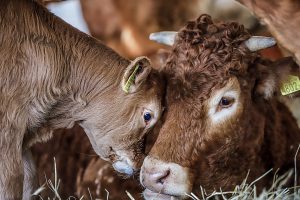An earlier piece I wrote about the lives of my rescued laying hens stated that they had been kept in horrific ways in their previous lives. I got a nice message from someone who told me that if I like to engage with farmers, I’d better not use these kinds of terms. Now, I am happy to engage with farmers and am open to advice. And, the writer is right about that, words do matter. The word gruesome is subjective and has a negative connotation. Polarisation lurks and no constructive conversation has ever been had from the trenches. The word gruesome says something about my opinion and nothing about facts. Farmers look at the living conditions of their broilers, laying hens, or parent and grandparent animals very differently. The government considers the way the animals are kept acceptable, although the debate on animal dignity is becoming more frequent. Consumers have limited opinions about it, and at least they do not show in the shop that they find it too gruesome.
Let’s leave opinions aside for a moment and look at the facts. What are those living conditions anyway? Recent Danish research shows that 85% of laying hens have a broken sternum. There is no doubt that this causes pain to the animals. Other research shows that after the fracture, the animals are in pain for at least three to four weeks, experience chronic stress and are in a depression-like state. (2020, Armstrong). A 2018 study of 51,000 broilers found that only 2.2% of the chicks had no problems walking, meaning that almost all chicks in regular farming are lame to a greater or lesser extent and experience pain in doing so. This is 38 million animals in pain in The Netherlands alone. And because these animals only live to be 6 weeks old, that’s more than 300 million animals on an annual basis.
And then there are the parent animals. This sector, which does not supply directly to consumers and is therefore not covered by a label, produces eggs from which broilers hatch. So the animals kept in this sector are the broilers’ parents. The hens, the mothers of the broilers, are fertilised by a rooster. They often live together in mixed houses, where there is little room for natural mating behaviour and where the hen cannot escape the rooster if he approaches her. The rooster’s (sexual) behaviour is influenced by genetic selection. Resulting in increased aggression of the roosters. The hens in the house are chased and injured by this rooster behaviour. The life of the hens is stressful and fertilisation regularly painful and bloody. The common solution to this problem is to remove the rooster’s rear toe. This backward pointing toe is the biggest cause of wounds in the hen. Removing the toe does indeed contribute to the welfare of the hen. But the rooster, made into an aggressive rapist by man, must first be mutilated to perform its function properly.
These circumstances are entirely within the legal frameworks we have established as a democracy. Nobody here is doing anything that is not allowed. I understand that people who keep chickens within the limits of the law feel attacked by my harsh words. They work long hours to provide a product for consumers who hardly ask questions about those living conditions. I will therefore try to stick to the facts. But can we at least agree that the way chickens are living now is undesirable? That improvements are necessary? Because only when we denounce the conditions of these animals is there a motivation to do something about it. Without a strong condemnation of their current life, we leave everything as it is. After all, that is easier, cheaper and less confrontational.



